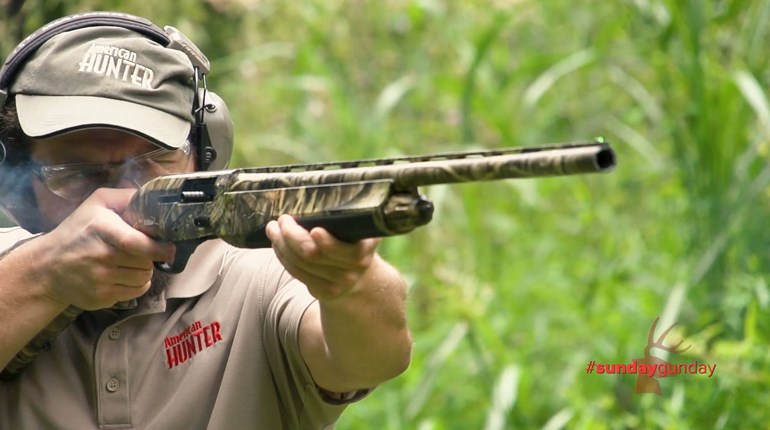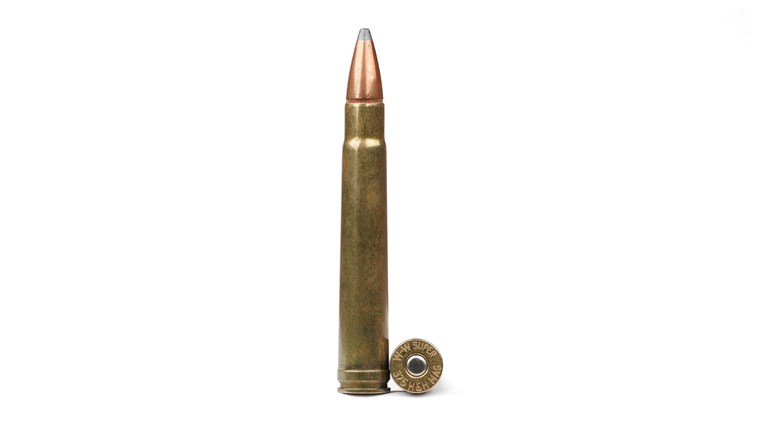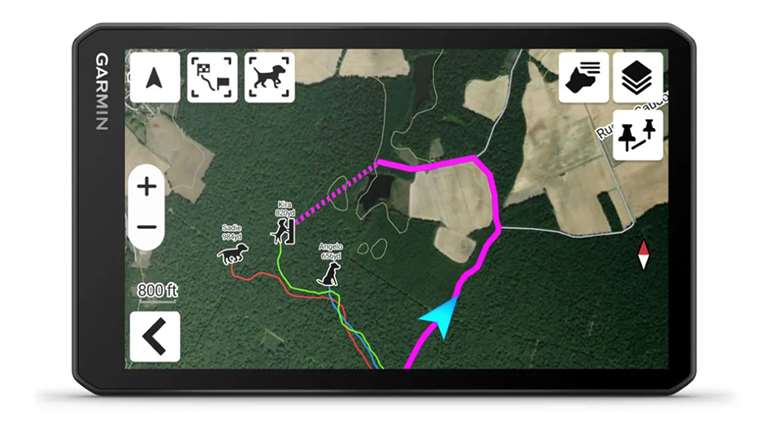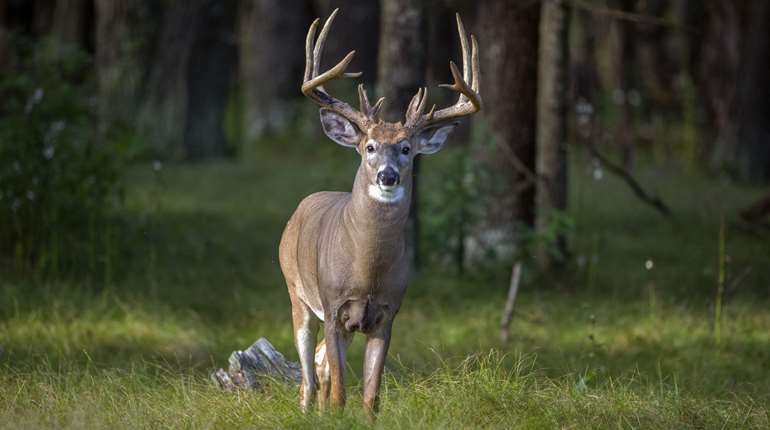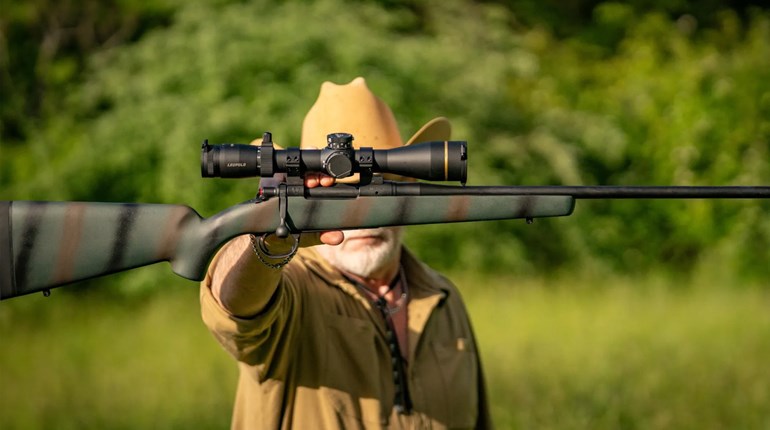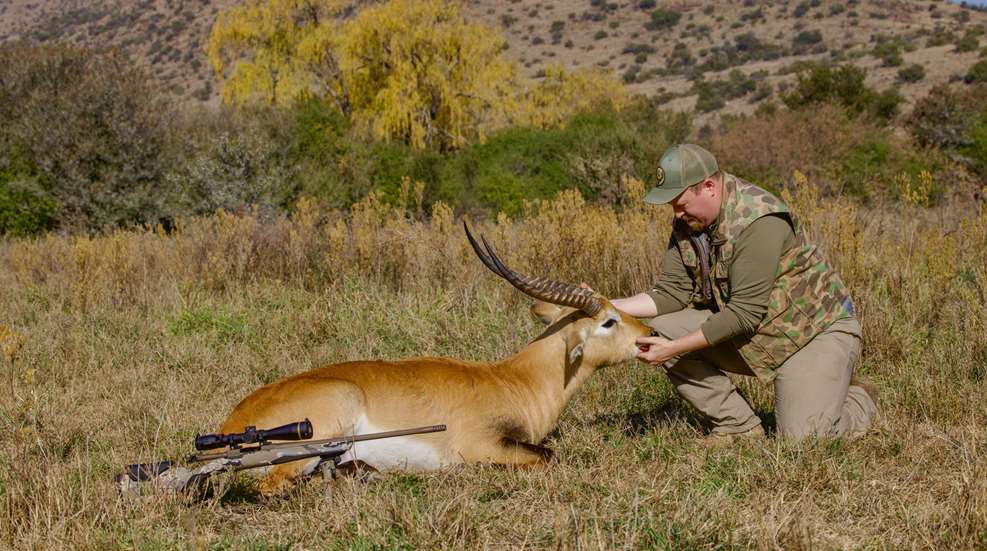
The view was ideal. From the peak of the small, brush-covered hill only a short, winding walk from the rut-strewn road, the entire valley and the far-side slope were visible nearly 180 degrees. It was kudu and nyala country: rugged and unforgiving, and veiled in just the kind of nasty bush that hides these hardscrabble giants from keen-eyed hunters. It was a spot we’d been to before; me, for the first time the day prior, and my PH, Pieter Zwiegelaar, probably more times than he could count. It was a known hot spot—known to him at least. From our vantage, we could hunt like they do in the American West: sit and glass, and wait for bobbing horns hidden in the bush to give the animals away, then set up for a shot as dark hides emerged against a small window of open gray earth. Spotting scope deployed—a Leupold SX-4 Pro Guide HD—we had probably 800 yards to glass out front and a couple thousand from side to side of a valley that was maybe 300 yards from top to bottom. It was a sweet little setup—game trails crisscrossed the hillside like a Candy Land game board, and I had high hopes King Candy himself would appear at some point during the week.
But like the Coues deer of the American Southwest, these critters, which I thought would be easy to spot from our position, were like ghosts, apparitions that would appear and disappear again by the time your eyes focused in on movement. The game that did offer opportunity, as it so often happens, was the type we weren’t after. While they were incredible to witness, the smaller bushbuck and warthogs that occasionally dotted the hillside were given a pass. We were eyeing for something a bit larger, something with spiral horns, and we were determined to make up for the missed opportunity that occurred less than a mile away the day before when a giant nyala poked its head out from the shadows not 10 yards from the road. On that occasion, we simply took too long to set up for what could have and should have been an easy offhand shot. I hadn’t thought about nyala until that moment, and the seconds it took me to consider and then decide to shoot him turned out to be the very seconds I needed to pull it off. Thankfully, unlike big-game hunting in North America, you rarely have only one chance at success in South Africa, and with a week to tote a rifle around, the odds were in my favor. …

Betraying my own cardinal rule for plains-game hunting, I came to the Eastern Cape of South Africa with a list of about 10 animals that I’d be happy to take home, with a plan to focus on the “oddballs” I hadn’t shot during any of my previous safaris. Forecasting the story I thought I wanted to write, my idea was “Big and tall, ugly or small, Jon likes them all.” Catchy, right? I’d already successfully hunted the most common sought-after species like gemsbok, kudu, zebra and blue wildebeest on previous trips, so this time I was going to focus on what I considered to be the oddities and the ugly—big and small; red hartebeest, black wildebeest and aardwolf topped my list. I know, I know, some of you are going to balk at my valuation, but there’s something about a red hartebeest that I find utterly unattractive. It’s as though after creating all the others, God blindly pulled from his leftover “plains-game parts” bin to put that animal together. As for the black wildebeest, it’s not as bad, but let’s be honest, the black wildebeest isn’t winning a beauty contest anytime soon. That said, they are cool animals, like little Cape buffalo, and a black wildebeest Euro would look great next to my blue.
The aardwolf is an oddity for sure. I’d never seen one in real life, and as far as what the pictures revealed, well, imagine a cross between a jackal and a long-haired hyena and you’ve got the idea. It’s about 15-20 pounds of insect-eating dog with a long, wire-haired coat and a face that screams “shelter-bound.” Bagging one would make for a fine conversation piece.
As ugly as some of these critters were, they are all absolutely unique, beautiful in their own right, and I was thrilled to get the chance to hunt them. I knew I wasn’t going to leave with all the animals on my list—I could afford only a fraction of that, and who knows what we would be able to find? But with an idea in my head of what I was potentially looking for, I at least had some direction for the week. Little did I know I’d soon be tossing the map and hunting on happenstance.
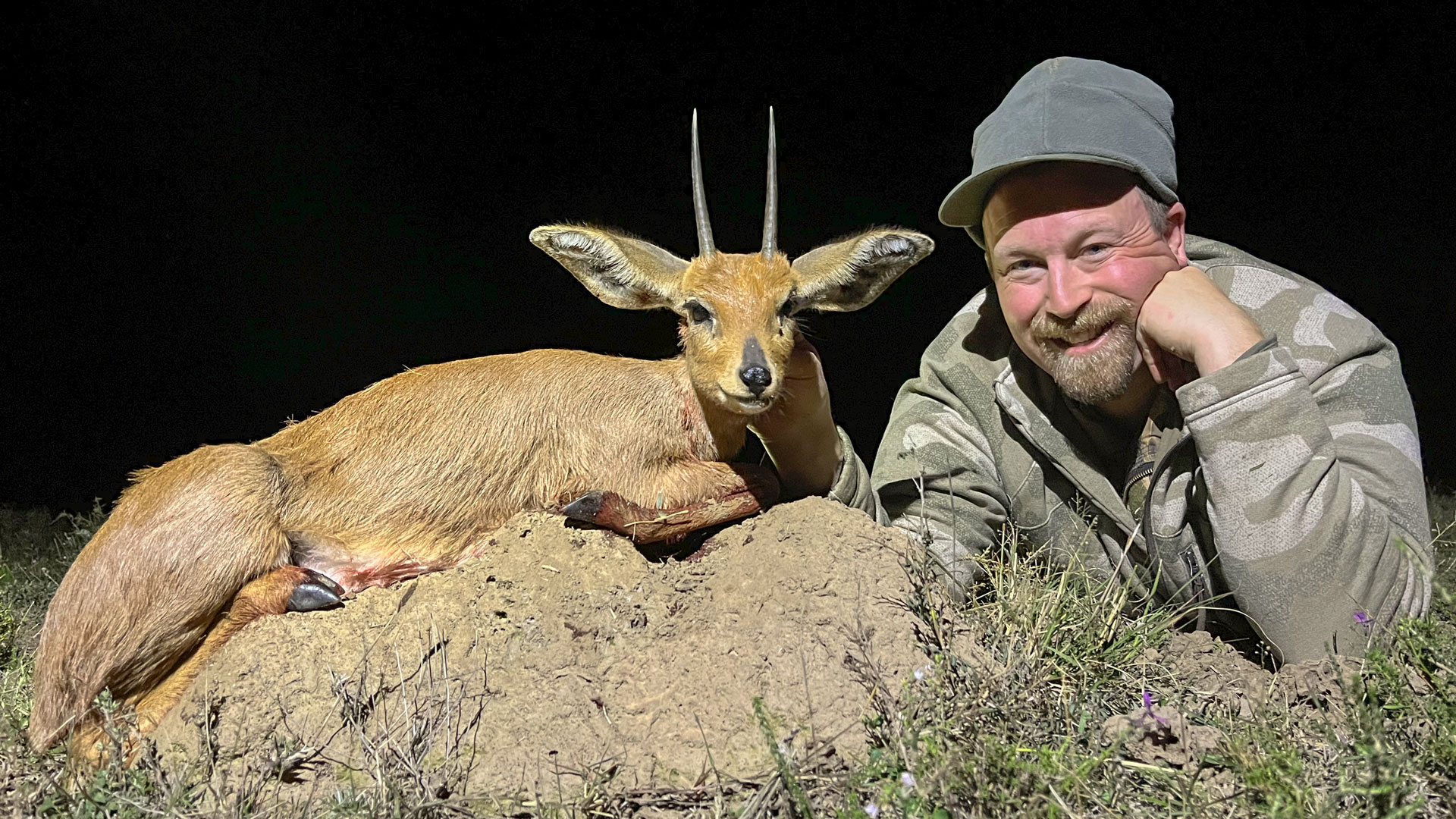
… Back in that valley, I was sure that at any minute a large, ivory-tipped nyala would step out from the bush and give me a shot at redemption, so I opted to stay put when Pieter informed me that he was going to take a stroll off to the left side to see what he could see. It was about 10 a.m., and though the sun was hinting that I ought to scout out some shade, the valley was still veiled in shadow and so I knew there was a chance the cooler air below could still waft a big critter my way. I sat with elbows on my knees and eyes on the glass, pulling away only to reposition and once or twice to pull a nagging thorn from my pincushion of a rear end.
About 30 minutes had gone by, light having about filled the valley completely, when I heard a rocky shuffle to my left and spotted Pieter pushing through the bush. Our eyes met, and he stopped about 30 yards out, waving frantically for me to come and join him. He’d spotted a nyala, I was sure of it, and based on his intense flagging it was a big one. I grabbed my rifle and made my way to meet him via a hushed speed walk while doing my best not to slip on the crumbling earth, throwing small rocks down the valley in my wake. With the shakes already setting in, Pieter grabbed my shoulder and said words I was not expecting him to say.
“Jon, do you want to shoot a waterbuck?”
Before I could even picture the animal in my head, he scratched that question all together and came at me with a different approach.
“Jon, you need to shoot this waterbuck. He’s huge. You don’t understand. If you don’t, I will.”
That’s all I needed to hear. No animal gets my blood pumping on a plains-game hunt more than an animal that gets my PH’s blood pumping. I simply nodded in the affirmative, eyes wide with wonder, as he grabbed my shoulder and said, “Come, quickly.”
It wasn’t easy keeping up with Pieter, but I managed to at least keep him in view as we two-timed it about a hundred yards to where he’d spotted the waterbuck. His bino was already pointed toward a distant hillside when I finally arrived, and I quickly raised mine in solidarity. I wasn’t even sure where to look, but I scanned the hillside opposite our position anyway.
I knew what a waterbuck looked like, but in the thick bush we were scanning every arcing branch deserved a second glance. Unless he stepped out completely, if this animal was even still there, he was going to be tough to find.
“Look for moving horns, or the big white circle on his ass,” instructed Pieter.
And that’s what finally gave him away. Like a giant bullseye target, the white circle on his rump stood out, even buried in the thick green bush just below the crest of the hillside, and it was easy for Pieter to walk my eyes right to him.
I quickly got on the sticks, my body trembling with excitement, and the waterbuck turned to show us his wide, towering rack. The sight of that animal squeezed what little breath I had left from my lungs like wringing water from a wet sponge, and though I had nothing to compare it to, I knew instantly that it was an impressive specimen. It’s really all a blur from there, but from what I can recall, Pieter dragged my increasingly limp body a few yards to the left to get a better shot angle, and I let my Browning .300 Win. Mag. do the rest.
The shot was good—right in the shoulder—but waterbuck, as I know now, are darn tough animals. Not wanting to lose and have to trail this animal in the thick bush we were dealing with, we immediately ran the ridge’s peak, busting brush for a few hundred yards to where the bull had been standing. Pausing for a moment, Pieter found blood quickly, raised his head to listen and instantly knew we were in trouble.
“He’s still on his feet. We have to get to him now,” he barked.
With branches whipping me in the face and thorns stripping flesh from my exposed arms, we pushed fast through the bush. We’d gone maybe 20 yards when Pieter stopped and pointed, “There!” He then turned to me, grabbed me by the shoulders and lifted my entire body like it was a sack of potatoes, my feet dangling in the air like a misbehaving child, and placed me back to the earth in front of him.
“Shoot him now!”
Through a small window of green, I raised my rifle and did as Papa commanded, cementing the waterbuck with a shot to the neck at less than 7 yards.
It was perhaps the most exhilarating half-hour of the week, and Pieter was right, the waterbuck was a beast. Not only was his body much larger than I had anticipated, but taping him off a short time later revealed roughly 32 inches of arcing horn on either side, the trophy of a lifetime in anyone’s book.
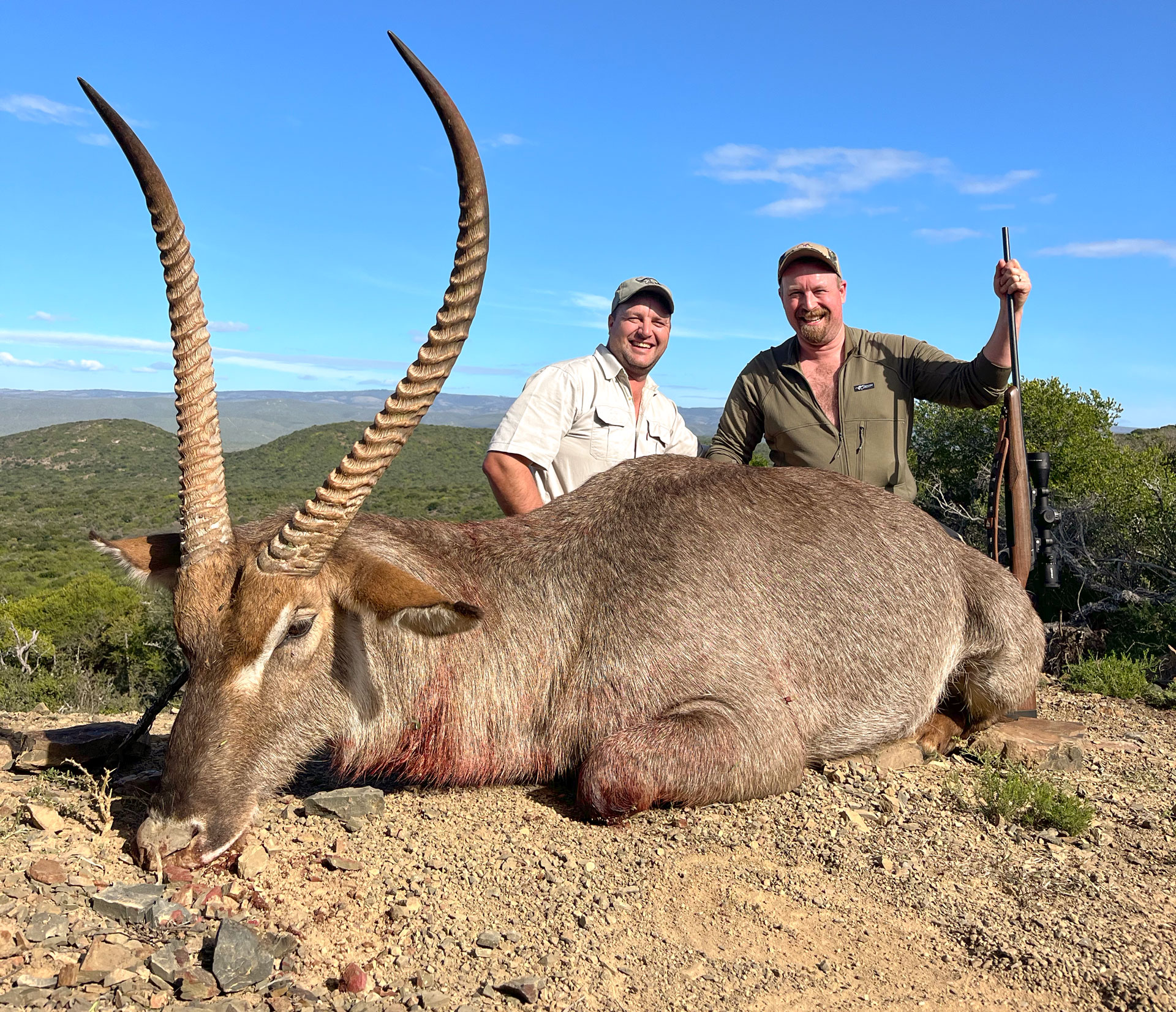
South Africa is a strange place, especially for an American hunter. When it comes to opportunity, it has no rival in all the world. Sure, North America has its fair share of big-game animals to pursue, but to do so you must acquire a tag, and that tag is almost always attached to a single species. I can’t count the number of times I’ve seen a beautiful, wide-racked mule deer with only an elk tag in my pocket, or a big bear from my whitetail stand with no option but to let him pass. It kills me. I recall on one occasion about seven years ago, the biggest elk I’ve ever seen in person stood broadside at about 60 yards in New Mexico, just begging for an arrow, and all I could do was pantomime the perfect shot before he winked, turned to scratch his butt with a giant tine then disappeared into the pines. I suppose most American hunters are used to that fact of life and simply enjoy the sight without too much distress, but I’ve been to Africa, where species-specific tags are as strange a concept as Marmite on toast is stateside, and it’s left me jaded. After hunting in a place where your budget is the only thing stopping you from pursuing the animal of a lifetime, watching game go by can become a painful experience. Budgets are malleable, tags are cemented in stone.
I did some quick math when we finally came upon the downed red lechwe shot by my good friend, Shawn Skipper, and was kicking myself for letting what could have been my only opportunity go to another. Charl le Roux, the owner of Rosedale Safaris and Shawn’s PH for the week, first spotted the lone bull about 500 yards off, broadside and naked in the vast open plains, and knew instantly that he was a bruiser. Shawn, the gracious friend that he is, immediately asked me if I wanted to take a crack. Knowing the cost of such an animal would put quite a dent in my budget, I decided to step aside and let him have a go at hunting the lechwe. A handsome animal at distance, he was downright gorgeous up close—no doubt one of the most beautiful animals I’d ever seen. Sleek and sexy, the red lechwe is a showstopper, and with one on the ground to fully take in, I decided right then and there that if given the opportunity again I wouldn’t hesitate to give up any number of other critters for the chance at taking one home. Pieter could hear it in my voice as I told him the tale that evening, and like a good wingman should, my PH decided right then and there he’d do his best to help me leave South Africa with a beauty.
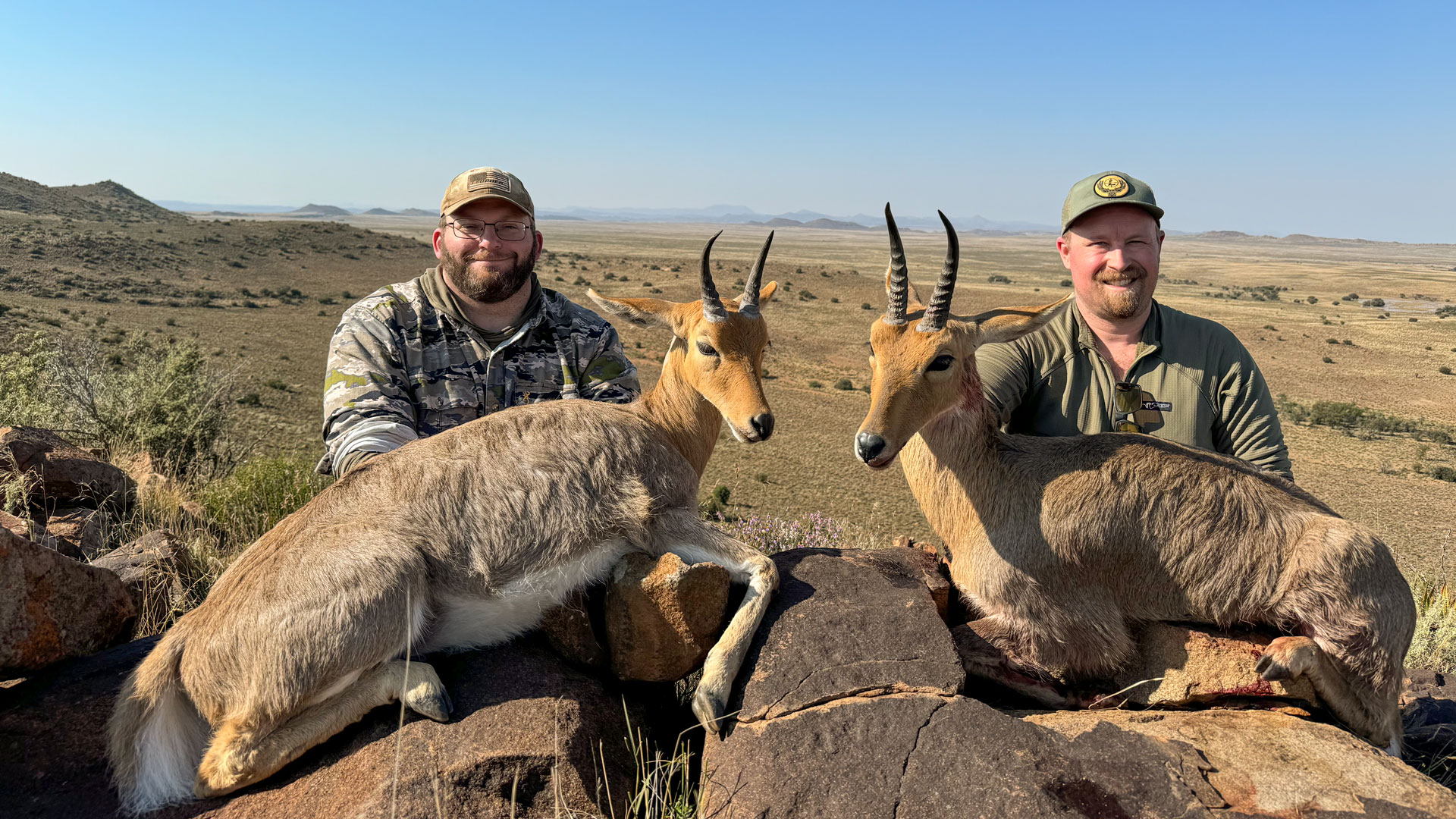
It was the following day when he surprised me with the opportunity.
“I just got permission to hunt a different property,” he said, “but we’ll have to leave now and stay overnight, as it’ll take us a few hours to get there. You up for it?”
While I’d be giving up an afternoon of hunting, at this point in the safari, I had full trust in Pieter and would have followed him to the ends of the earth in search of a good time.
“If you think it’s worth it,” I replied, “then lead the way, captain.”
His big grin was almost devious. “It’s worth it,” he shot back. “Gather your gear. We leave in 20 minutes.”
The following day, after a magnificent breakfast that Pieter had prepared for our team, we drove into the new property and found the ranch manager waiting. I had no idea what we were going after—my list had basically been scrapped—but I trusted Pieter and knew that we’d have a good time hunting, whatever we found.
“Looking for lechwe?” asked the ranch manager. “There’s a big bull that likes to hang out just on the other side of that ridge.”
Pieter smacked me on the back, “I got you, buddy. Let’s go get your lechwe.”
We found the big bull, along with about 40 cows of his harem, feeding in a sheltered meadow about the size of two football fields. Tagging them with the Leupold BX-4 Range HD rangefinding bino on my chest, we knew it was going to be a decent poke, around 350 yards. I opted to use my companion’s flat-shooting 6.8 Western rifle that had proven to be a downright tack-driver on this trip.
Positioned high above the herd on the edge of a cliff, I went prone on the bipod and steadied my breathing before sending one beautiful bullet on a collision course with what to this day is the prettiest game animal I’ve ever taken. That Browning 6.8 proved itself a one-shot killer yet again—the magic stick as we’d begun to call it—and the lechwe ran about 35 yards before falling to the ground.

Putting my hands on that magnificent animal’s gorgeous golden hide that blended to auburn atop his back and faded to black on his front legs, finally grasping the wide, ringed horns that sweep back before gently arcing ever so slightly forward, was a moment I didn’t want to end. But it was the end, my last animal and the culmination of a week-long safari with some of my favorite people and a PH that proved to be of the finest I’ve ever had the pleasure of hunting with.
Though my original plans had been thrown out the window, along with my intentions for this story, I was beyond satisfied. I’d shot plenty of game, including a few from my list—a big, ugly black wildebeest, ostrich and mountain reedbuck—along with a broken-horned bushbuck and a few of the smaller antelope available—steenbok and common duiker. By far the most satisfying, though, were the two I hadn’t even considered, what I now believe may be the most striking animals I’ll ever have the pleasure of hunting: the towering waterbuck and the stately red lechwe. I should have known: In South Africa, always expect the unexpected. In the land of endless possibilities, you just never know what may be waiting behind the next bush.
*I can’t say enough good things about Rosedale Safaris and the operation that Charl le Roux and his wife, Julia, have put together. From the immaculate and comfortable accommodations to the savory meals crafted right there in Julia’s kitchen, and Charl’s onsite taxidermy studio, the le Rouxs go to great lengths to ensure you experience the safari of your dreams. With more than 40 species available to hunt, whether on the main property or any of the more than 110,000 acres of private land concessions Charl has access to, you can be sure it’ll be under the guidance of some of the most professional and capable PHs South Africa has to offer. rosedalesafaris.com

Plains Game Gear
As a PH recently told me, American hunters like to shoot long, and they bring with them equipment capable of doing so. While a good PH will still do his or her best to get you as close as possible, they’ve gotten used to American clients who like to stretch things out on occasion. My longest shot was just shy of 400 yards, but I had equipment with me capable of going much longer.
The Browning X-Bolt 2 is a prime example of a rifle that’s more than capable at any range you are. I utilized two variants on this hunt, the X-Bolt 2 Speed SPR and the X-Bolt 2 Hunter. Both were incredibly accurate, certainly capable of much more than I am. The Speed SPR was chambered in 6.8 Western, a cartridge fast becoming a personal favorite. Wearing the company’s Vari-Tech composite stock, the rifle boasts an array of adjustments that allow the shooter to tailor fit the rifle and optic combo perfectly, including LOP, comb height and grip angle adjustments. A shorter, 20-inch, free-floating barrel keeps things light, while allowing room for a suppressor to be added. The company’s adjustable DLX trigger breaks clean, and set at about 3 pounds adds to the accuracy potential. Top it off with a redesigned three-lug, fluted bolt with a short and fast 60-degree lift, the time-tested and proven X-Bolt action and removable rotary magazine, and you’ve got a rifle that’s built to reliably handle anything Africa throws its way.
If you’re looking to go the more traditional route, the wood-stocked X-Bolt 2 Hunter is a thing of beauty. It features all the same upgrades to the ergonomics, bolt and action, bedded in a handsome walnut stock. Mine was chambered in .300 Win. Mag.—a proven African contender capable of taking just about any animal that walks the plains. browning.com
Of course, a rifle is only as deadly as the ammo you put through it, and the Winchester and Browning loads I ran in South Africa proved to be great choices. For the 6.8 Western, I went with Browning’s Long Range Pro, loaded with a 175-grain Sierra Tipped MatchKing bullet. It’s got an incredible BC of .617 and sends its payload at a blistering 2835 fps from the muzzle and maintains over 2,200 ft.-lbs. of energy at 300 yards. It’s a killer cartridge, penetrating deep with beautiful expansion, which I witnessed accomplish one-shot kills on everything from springbok to lechwe, kudu and roan. browningammo.com
For the .300 Win. Mag., I went with one of my all-time favorites, the tried-and-true Winchester Expedition Big Game, loaded with a 190-grain AccuBond Long Range bullet. It’s a heavy, hard-hitting bonded bullet that has always delivered devastating results on game, penetrating deep with awesome weight retention, and its tipped, boattail design gives it a .597 BC for incredible accuracy. winchester.com
Topping my .300 Win. Mag., was a Leupold Mark 4HD 2.5-10x42 FFP optic. Lightweight and with all the magnification a hunter could ever need, this little package is fast becoming one of my favorites. Leupold’s Professional Grade Optical System—a marketer’s way of saying top-notch glass and coatings—provides incredible light transmission, clarity and glare reduction, the latter an absolute necessity when hunting a place like South Africa where from dawn to dusk the sun’s harsh rays are never absent. Though its TMR FFP reticle sports all the mil dot hash marks you need for quick holdovers, Leupold also tops the Mark 4HD with its M5C3 ZeroLock adjustment turret, providing up to 30 mils of elevation adjustment with a dependable return-to-zero feature. If you’re looking to get a bit more customized, the Mark 4HD scope is compatible with Leupold’s Custom Dial System (CDS), allowing you to match your turret with your rifle’s exact ballistics and environmental conditions. With a CDS dial installed, all you need to do is range a target, turn the dial to that number and pull the trigger for dependable and repeatable hits on target. leupold.com












